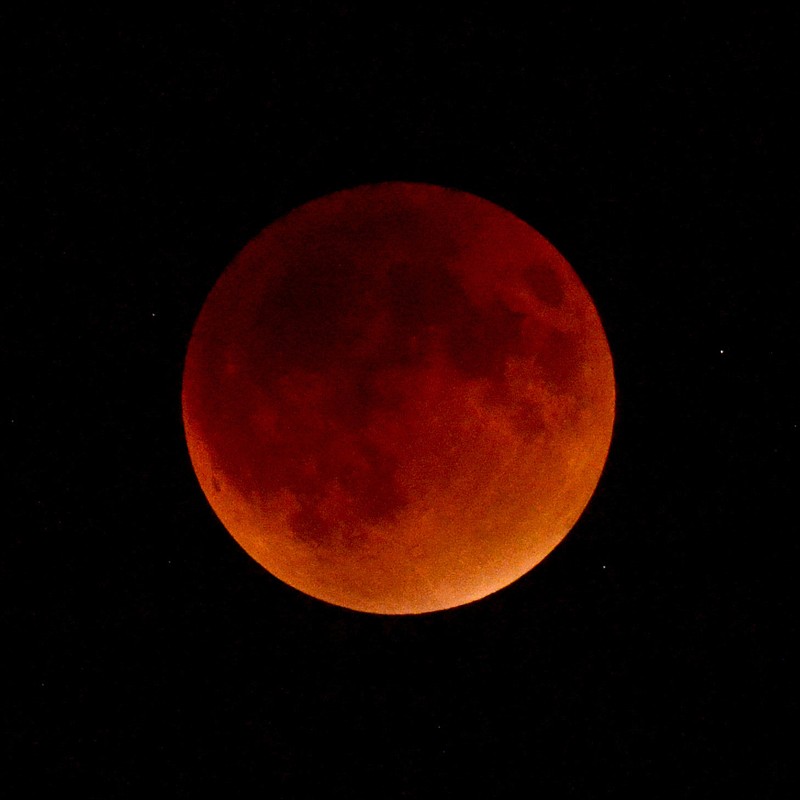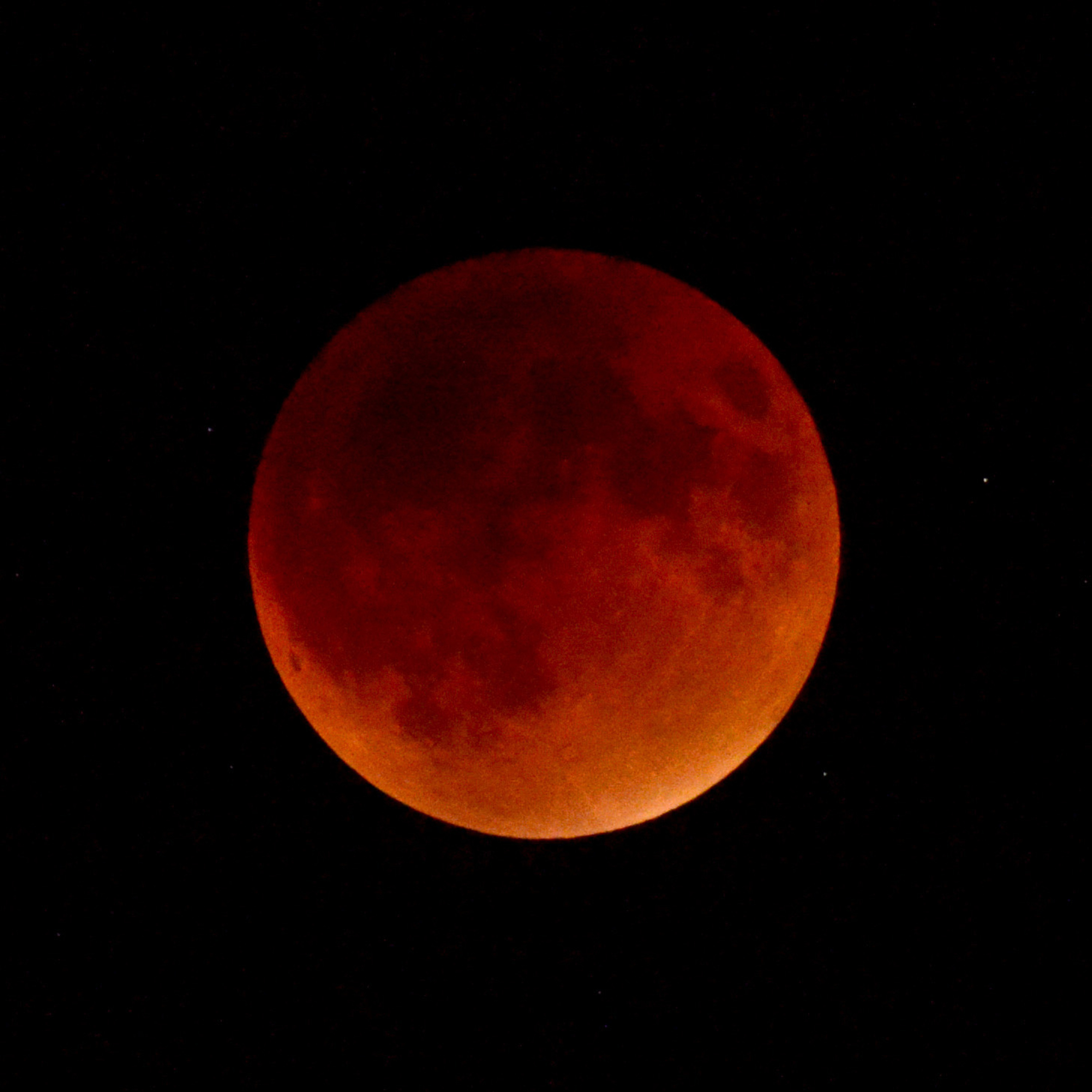We are no more likely to have a zombie uprising, werewolf polka, Bigfoot encounters, end of the world, etc. [during this total lunar eclipse] than under any other full moon.
When to see it
Here’s the timetable for Sunday night’s total lunar eclipse. All times are Eastern Standard.9:36 p.m. Lunar eclipse begins11:41 p.m. Total eclipse begins12:12 a.m. Maximum eclipse12:43 a.m. Total eclipse ends2:48 a.m. Lunar eclipse endsSource: NASA via AccuWeather
Did you know?
Sunday night’s total lunar eclipse is the only one of 2019 and, therefore, the last of the decade. The next won’t occur for more than two years, on May 26, 2021.
Look skyward
Other notable astronomical events this year include:› May 6-7: Halley’s Comet to spark Eta Aquarids meteor shower› July 2: Total solar eclipse darkens sky over South America› Aug. 12-13: Perseids meteor shower› Nov. 11: Mercury to track across the face of the Sun (a rare planetary alignment; Mercury is typically a difficult planet to find in the sky due to its close proximity to the sun, but in November, it will pass directly between the Earth and the Sun, appearing as a small black dot on the Sun’s surface)Source: AccuWeather
Scientists haven't landed on the hows and whys behind the mysterious radio signals emanating from outer space. But a celestial event happening Sunday night is easily explainable - though it arrives with its own portent.
Sunday night is not only a total lunar eclipse but a relatively rare astronomical occurrence in which the moon will turn a rusty shade and loom larger in the sky than usual.
Weather cooperating, this "super blood wolf moon" will be visible in the skies in all of North America and South America, as well as parts of Europe and Africa, potentially making it "the most-viewed astronomy event of the year," according to AccuWeather.
Chattanooga-area residents may be disappointed, though. At press time, forecasts were calling for partly cloudy skies overnight.
"Normally I would stock up on MoonPies and be all about this event, but it appears like the meteorologist in me may spoil the fun for astronomers out there," says Thom Benson, director of external affairs at the Tennessee Aquarium and a former WRCB-TV meteorologist.
"Sky cover during the eclipse may be more than 40 percent," he predicts.
Lunar eclipses occur when Earth's shadow blocks the sun's light, which otherwise reflects off the moon, explains Space.com. There are three types - total, partial and penumbral - with the most dramatic being the total lunar eclipse, in which Earth's shadow completely covers the moon.
A lunar eclipse can occur only at full moon, and a total lunar eclipse can happen only when the sun, Earth and moon line up perfectly. Anything less than perfect alignment creates a partial lunar eclipse or no eclipse at all.
Sunday night's total lunar eclipse will appear similar to those in the past, but contributing factors have earned it the unofficial nickname of the "super blood wolf moon."
"Although it's a bit of a silly-sounding name, it does have a basis in some real phenomena," Caleb Scharf, director of astrobiology at Columbia University, tells AccuWeather.
"Blood moon" simply refers to a total lunar eclipse, according to the Old Farmer's Almanac website. It is not a term used in astronomy.
"The moon is red because of Rayleigh scattering," explains Jack Pitkin, a chemistry and physics specialist at the University of Tennessee at Chattanooga and operations manager of UTC's Jones Observatory off Brainerd Road.
Rayleigh scattering refers to the scattering of light off the molecules of air - basically the answer to "Why is the sky blue?"
"The light reaching the moon is reflected from the Earth," Pitkin says. "The light reaching the moon passes through the thickest part of the atmosphere. Only red light has a long enough wavelength to go through the atmosphere. Blue light is scattered more. The moon is red for the exact same reason sunrises and sunsets are red."
This eclipse also falls during the first supermoon of 2019, when the moon appears slightly larger than normal.
The "wolf" reference goes back to Native American and early Colonial times, according to the Old Farmer's Almanac. Similar to the harvest moon in fall, the full moon for January was called the full wolf moon because "it appeared when wolves howled in hunger outside the villages."
If Sunday night's weather conditions improve, anyone wishing to see the moon turn red will have to stay up late as the eclipse will not reach its peak until around midnight.
The first phase of the eclipse, known as the penumbral phase, will begin at 9:36 p.m. EST. However, the moon may not become noticeably darker until the partial phase of the eclipse begins at 10:34 p.m. EST, says AccuWeather.
The most-anticipated part of the eclipse, totality, will begin at 11:41 p.m. and last for around an hour as the moon passes through Earth's innermost shadow. This is when the moon will turn rusty orange or red in color.
The total eclipse is set to end around 12:43 a.m., after which the moon will gradually regain its normal color.
Pitkin says the observatory will be closed, but sky watchers simply need an unobstructed view of the horizon to see the eclipse.
"You do not need a telescope," he says. "Binoculars or naked eye would work just fine."
Sunday night's bulging redness notwithstanding, eclipses could be considered fairly ordinary. Every year, reports EarthSky.org, there are four to seven eclipses - some lunar, some solar, some total, some partial.
The fascination with so-called blood moons is thought to be linked to a 2013 book by John Hagee, "Four Blood Moons: Something Is About To Change." In 2014-15, Hagee and fellow Christian pastor Mark Blitz spoke of an astrological phenomenon known as a lunar tetrad - four successive total lunar eclipses - that they linked to biblical prophecy.
Writing for Space.com in April 2014, astronomer Geoff Gaherty said he was saddened that "'prophets of doom' view these life-enriching events as portents of disaster" and said the eclipse was "hardly something to be concerned about."
Nevertheless, the term endures, much to Pitkin's consternation.
"The less I hear it, the happier I am. We are no more likely to have a zombie uprising, werewolf polka, Bigfoot encounters, end of the world, etc. than under any other full moon," he says.
"This [an eclipse] is what happens when an inhabited planet orbits a midsize star and a relatively large moon orbits the planet. Deal with it. Just kick back and enjoy the show."
Contact Lisa Denton at ldenton@timesfreepress.com or 423-757-6281.

